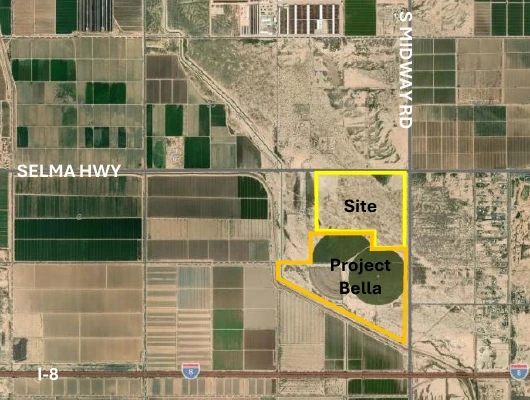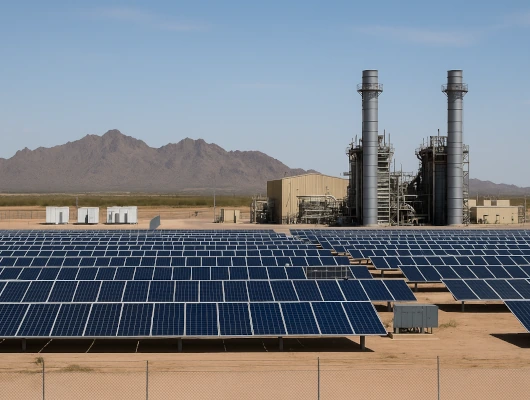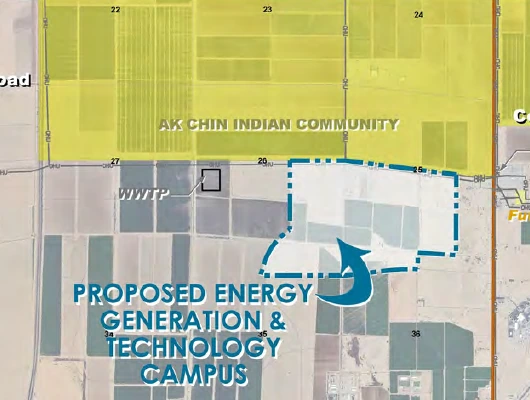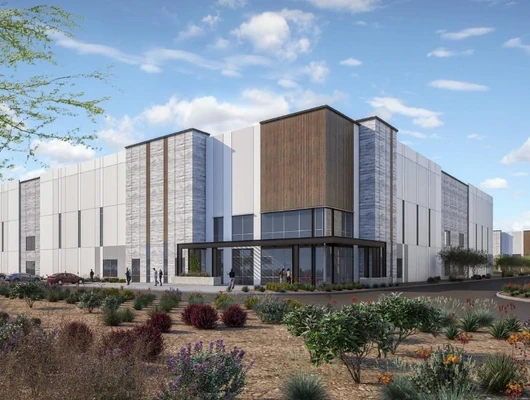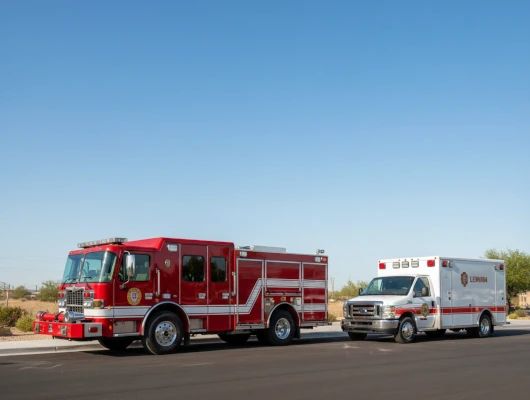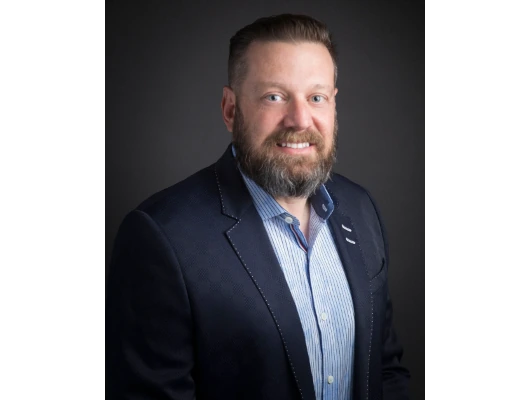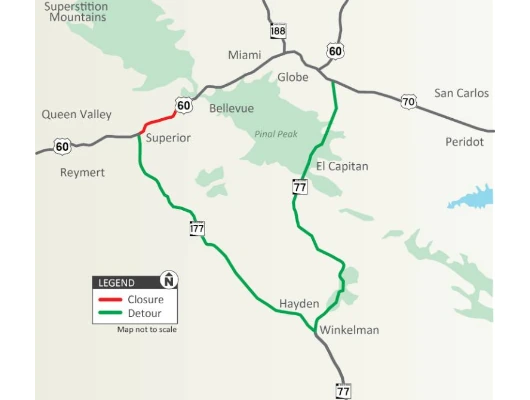Key Points
- Unanimous Vote: The commission approved Project Midway 8–0 on October 16, 2025.
- Large Site: The proposal covers 215 acres near Selma Highway and Midway Road.
- Facility Plan: About 70 acres would hold data centers and a 10-acre substation.
- Power Demand: The project needs 225-megawatts, nearly all of ED3’s current capacity.
- Project Bella Link: Roughly 40% of power may come from Project Bella’s gas and battery plant.
- Utility Concerns: ED3’s manager said the utility has not met with the developer.
- Water Use: The project claims 11,500 gallons per day, for domestic and landscaping only.
- Cooling: The data center would use air cooling, not water cooling.
- Noise: Backup generators could cause sound issues; a study is planned.
- Economic Impact: The project represents $6.5 billion investment and 225 jobs averaging $93,000.
- Fire Coverage: It would help fund a new fire district for the area.
- Next Step: The Board of Supervisors will review the plan before rezoning.
The Pinal County Planning and Zoning Commission voted 8-0 on October 16, 2025, to forward the Project Midway data center proposal to the Board of Supervisors with a favorable recommendation. The vote follows a July work session where commissioners first reviewed the 215-acre development planned for the southwest corner of Selma Highway and Midway Road. The site sits just north of I-8 on vacant desert land in a sparsely populated area.
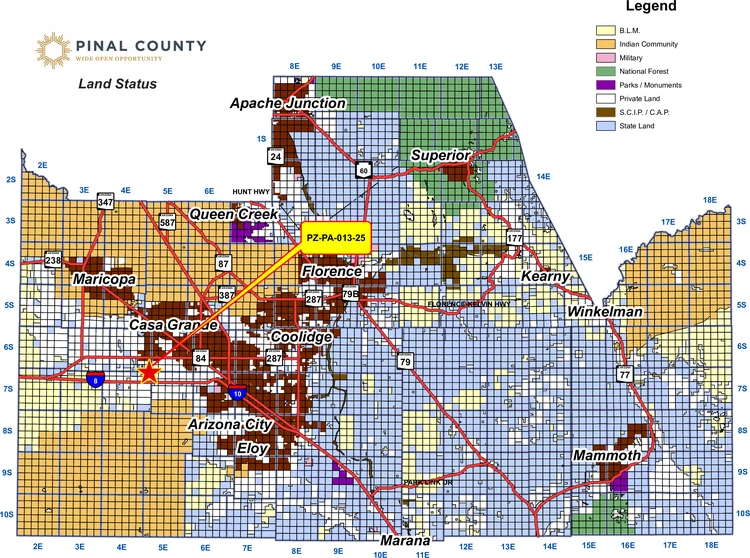
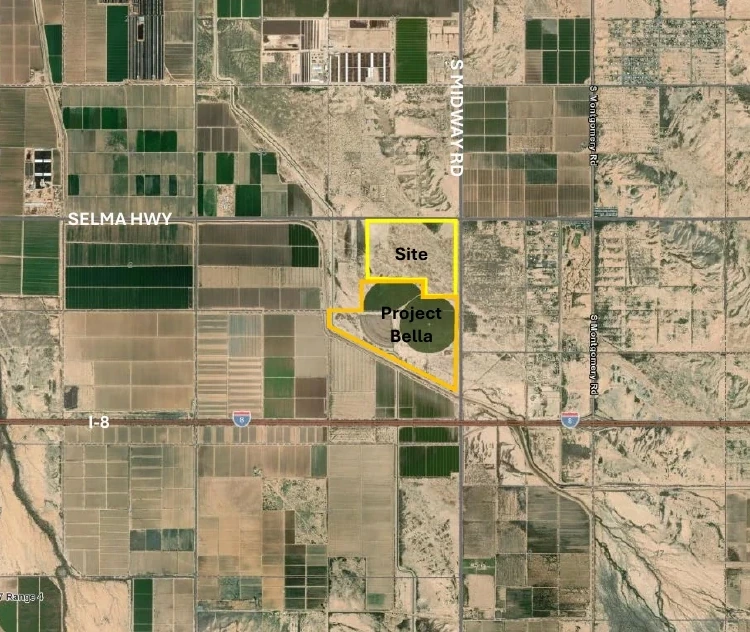
The commission’s October hearing focused on specific concerns about water consumption, power reliability, and noise impacts. The discussion marked the project’s shift from initial review to formal consideration.
The Proposal
Alex Hayes of Withey Morris Baugh PLC represented the developer, LPI Group. He requested a major comprehensive plan amendment to change the land designation from Moderate Low Density Residential to Employment. The change would allow the property to be developed as a data center campus with supporting industrial uses.
The conceptual plan shows a development footprint of approximately 70 acres—about one-third of the total site. The facility would include a 10-acre project substation located between the data center and the previously approved Project Bella power facility to the south. Hayes described the design as modern office park-style buildings rather than heavy industrial structures.
“This is going to look and feel more like an office park,” Hayes told commissioners. “We’ve heard a lot from the Board of Supervisors that with new developments like this, aesthetics are really key.”
Site Location and Infrastructure
The El Paso Natural Gas pipeline runs diagonally across the property. This existing infrastructure, along with nearby high-voltage transmission lines, makes the site attractive for energy-intensive development.
To the west of the property sit a small number of homes. A quarter to half-mile east lies a large-lot subdivision. Project Bella, the 480-megawatt natural gas generation and 440-megawatt battery storage facility that received final zoning approval in September 2025, sits directly south of the proposed data center site.
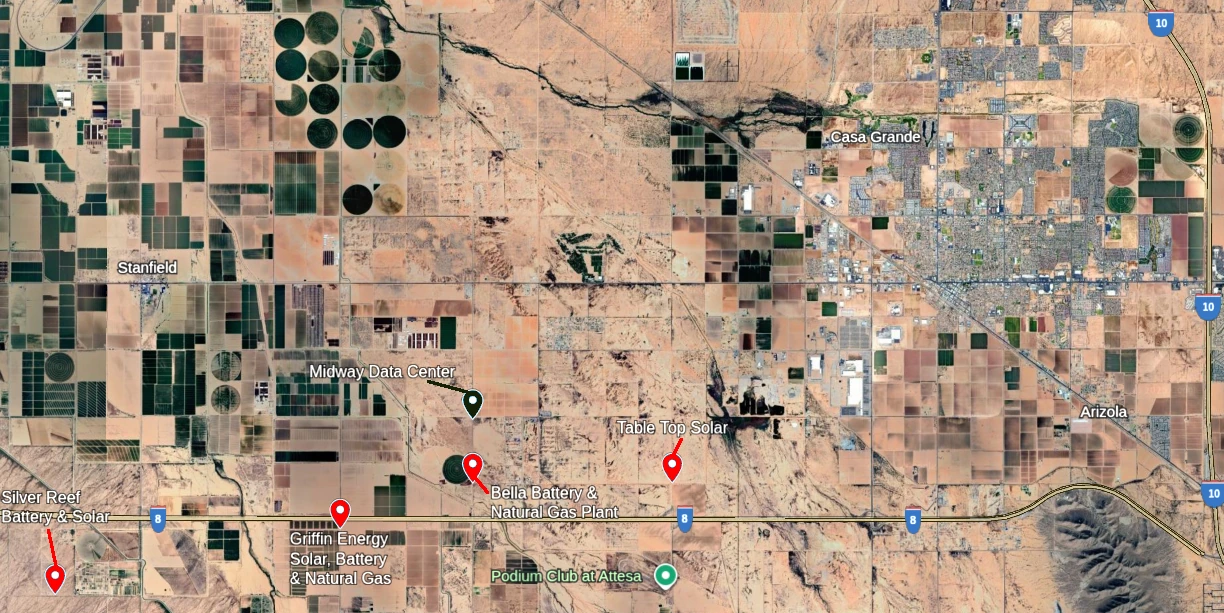
Power Requirements and Project Bella Connection
The data center’s power needs emerged as a central discussion point. Hayes explained the facility would require approximately 225-megawatts total, with about 100-megawatts projected to come from Project Bella’s 900-megawatt capacity.
The applicant’s presentation outlined specific power sources:.
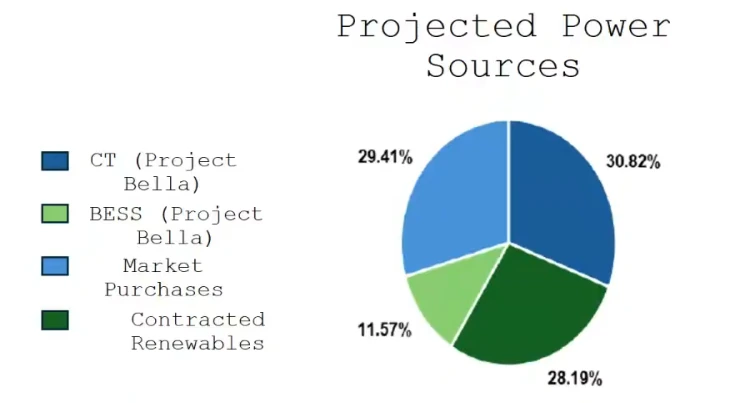
“About 40% of the power for this project would come from Project Bella from its natural gas generation and battery energy storage,” Hayes said. “About 30% would come from contracted renewables, including imported wind from out of state, so we’d actually bring power into the state. And then about 30% from the spot market.”
Project Bella’s total capacity reaches approximately 900-megawatts between natural gas generation and battery storage. Hayes emphasized that the development would not impact existing ED3 customers.
“All of this would be paid for by the developer and by the end user. This wouldn’t impact any existing generation capacity for ED3,” Hayes said. “ED3 would just be kind of the pass-through power provider. That means that they would actually take revenue from this project with minimal expenses for new transmission lines, new generation.”
Power Reliability Questions
Commissioner Karen Mooney pressed Hayes on power allocation disparities. “How come this project can get 40% of their energy from Project Bella, but we can’t get it guaranteed for any residents in the same area?” she asked.
Hayes responded that proximity and special contracts enable the arrangement. “Part of it is due to the proximity to the site and why it’s of value to be co-locating with generation like this, and it’s the ability to do this via the special contract with the utility provider. So the end user of this data center user on this site would contract with ED3 for specific power providers.”
Mooney followed up: “I mean, I understand the power grid, but we’ve heard from everybody, not just today but in previous, it just goes in and we can’t say where it goes. But here, they’re going to give 40% so I’m just trying to understand the concept.”
Hayes explained that electric utility service involves complex regulatory processes. “It’s not as simple as saying, ‘I want this electron delivered to that site,'” he said. “Utility providers have a very complex process of sourcing power to meet the demand of their service territory at its peak demand.”
Commissioner Daren Schnepf asked whether Project Bella was necessary for the data center to move forward. “If this project gets approved going through at the point when you’re ready to construct, are you coordinating with Project Bella? Because the requirement of the data center is going to sound like it needs a lot of power, energy from Project Bella. So you wouldn’t be putting the cart before the horse?”
Hayes confirmed the dependency. “Project Bella would be a necessary component for this project moving forward. And Project Bella is still on track for a 2028 operation date. But that coordination is ongoing, kind of in tandem with Project Bella with ED3.”
He added that the data center would likely be developed in phases with lower initial demand, but stressed that “any power provided to this site would be paid for and secured by the user.”
The proposal also highlighted Project Bella’s backup generators as a reliability feature. “One of the key needs of a data center is consistent and reliable power,” Hayes said. “In this case, Project Bella could actually for a large part serve that function, providing that backup power and essentially offering a micro grid for this project.”
ED3 Coordination Concerns
Brian Yerges, general manager of Electrical District Number Three, addressed the commission to clarify his utility’s involvement. “ED3 has sent a letter to engage with the applicant, but we have not had any meetings with the applicant,” Yerges said. “When I attend a public meeting and I see that ED3 is referenced, I have an issue with that.”
Yerges emphasized he was not opposing the project but wanted to ensure proper coordination. “We have a study process that we need to go through for interconnection, and we would just ask that the applicant engage with us timely, and that potentially maybe you make that a stipulation to engage with ED3 to go through this study process,” he said. “Our name is up there, but we have not been involved in any discussions. It’s the first time I’ve seen that presentation.”
Hayes responded that coordination to date had occurred through Project Bella. “Our coordination to date has been with Project Bella, who has been in turn coordinating with ED3, and my understanding is there’s a meeting between the applicant, Project Bella and ED3 later this month,” he said. “But it sounds like we do need to have some additional coordination in the short term directly between the applicant and ED3.”
Data Center Power Needs Nearly Match Utility’s Entire Customer Base
ED3 is responsible for power distribution in the area, while Project Bella would handle power generation. The scale of the data center’s power needs becomes clear when compared to ED3’s current system capacity. The data center would require 225-megawatts of total power. Of that, approximately 100-megawatts may come from Project Bella, with the remaining 125-megawatts sourced from contracted renewables and market purchases. For comparison, ED3 reported in August 2025 that its system peak demand reached 280-megawatts—a record for the utility. The data center alone would consume nearly as much power as ED3’s entire existing customer base at peak demand.
Water Consumption Debate
Water usage drew sharp questions from commissioners and opposition from residents. The application stated the facility would use 11,507 gallons per day.
Commissioner Tom Scott asked about the water source. Hayes confirmed Arizona Water Company would serve the property. When Scott pressed for details about the 11,500 gallons daily, Hayes explained the water would go toward “domestic water and other operations” but not cooling. “Probably some landscaping, yeah, and domestic waters,” he said.
Robin Davis, a nearby resident, challenged the water figures during public comment. “He lost me at 11,500 gallons per day,” Davis said. “My neighbors out in the rural portion of Hidden Valley and Thunderbird Farms are having to drill their wells deeper because the aquifer is being depleted.”
Hayes responded to water concerns by converting the daily figure to annual measurements. “You hear 11,000 gallons a day and it sounds like a very big number. But when you do the math, and it’s 12.8 acre feet per year, that really is a very small number, especially when you think about compared to other industrial or even residential uses over a site about 215 acres,” he said.
Hayes emphasized the facility would use air cooling rather than water cooling. “In places like the desert Southwest where it’s a low water environment, these new data centers, the modern data centers have the technology to operate with air-cooled systems that don’t require really any water at all,” he said.
He cited a Mesa project where “the largest water demand for the entire property is the landscape requirements that the city has on that property.”
Cooling System Questions
Commissioner Mooney asked Hayes about the risk of switching from air to water cooling. “Any projects that you’ve worked on that are air-cooled, have they had to be switched to water-cooled?” she asked. Hayes said he had not seen such a change. “Not to my knowledge. I think, as has been discussed previously, that would be a pretty substantial change.” Commissioner Scott asked for clarification: “So you’re not using water to cool with, you’re going to use something similar to what I have at my house for air conditioning?” Hayes confirmed: “That’s correct. It’s chillers. It requires additional power, but it’s not water cooled.”
Noise Concerns and Mitigation
Scott raised questions about noise after reading about data centers near residential areas. “Some have commented that in the evening time periodically, they have backup generators and they pop on every once a week or something like that. Is there any way to put like a muffler system or a sound depressor on there?”
Hayes said engineering solutions exist. “Every project’s different, but there are engineering solutions that can mitigate the sound impacts of generators and chillers and other project components. It’s just how the project’s designed and where the facilities are located and what measures would make sense in that situation.”
Scott followed up: “So is there any annoying hum noise or a high pitched noise that just resonates from a data center?”
Hayes pointed to the location’s existing noise environment. “Most of the noise comes from the chillers, from the cooling equipment. But the thing about this area is it’s going to be next to Project Bella. There’s the 500 kV transmission lines, which have their own noise and it’s also about less than half a mile away from I-8. I’ve seen the sound studies from Project Bella and there’s quite a bit of background noise at this location.”
Tena Dugan shared firsthand observations from visiting data centers in Chandler during public comment. “I took a drive to the two data centers in Chandler off of Price Road and Dobson,” she said. “I stopped a man walking that day and said, ‘Tell me what you think about this data center here. Tell me about the noise.’ He said, ‘It doesn’t really bother me. I can go in my house and I don’t hear it. But let me tell you, when they turn on those backup generators once a week, it’s awful. And they do it every week and there’s nothing to buffer it.'”
Dugan visited multiple locations. “I went into the neighborhood off Dobson, by where Uncle Richard used to have his dairy, and I got out of my car and the very first thing I heard, even with all the traffic on Dobson Road, was that hum. And it was terrible. It was just a constant hum.”
She knocked on a resident’s door. “The lady was so nice. She has children. She said, ‘It doesn’t bother me, except for when those backup generators go off. It’s an awful noise,'” Dugan recounted. “And that first guy I talked to, he said, ‘If you’re going to live near one, I’d do everything you could to oppose it, because it’s not fun.'”
Vice Chairman Robert Klob acknowledged the Chandler issues. “I know Chandler is looking at ways to fix some of those problems as well. So, sometimes we have to learn from our mistakes, and I know Chandler’s trying to be proactive, and somewhat reactive, but trying to get that fixed,” he said.
After public comment, Mooney asked whether sound barriers would be explored. Hayes committed to studying the issue. “We would be happy to look at, as part of the zoning and site plan efforts, I think we’ll do a sound study, and look at what the potential sound impacts are and if sound mitigation is needed, we can definitely look at measures. I don’t know if it’ll be a sound wall, but there are engineering solutions to reduce the sound.”
Klob noted that sound engineers could be engaged to study transmission patterns, and that the commission could add stipulations on decibel levels during the zoning phase.
Fire Service Extension
Hayes highlighted that the area currently lacks fire service coverage. The Pinal County Fire and Medical Authority—an extension of the Arizona City Fire District pending Board of Supervisors approval—will expand its service territory to include this area, benefiting both the projects and surrounding residents.
He described the benefit to existing residents. “We talked to one of the neighbors of this property and they pay an additional $5,000 a year just in property insurance because they don’t have fire service and that would change once this service is extended to this area.”
Economic Impact and Jobs
Hayes presented an economic impact analysis estimating the project would create hundreds to thousands of construction jobs and 225 permanent positions with an average annual salary of $93,000.
“These 225 full-time jobs have an average annual salary of $93,000 a year. That’s roughly three times the median salary in Pinal County,” Hayes said. “These are serious jobs with a trickle down impact in the community, significant economic impact, not just in the immediate surrounding area but throughout the county and the state.”
According to the applicant’s economic impact study, the project would require total capital investment of approximately $6.5 billion for a 225-megawatt facility. Through multiplier effects, the project could support an additional 190 indirect and induced jobs with $5.9 million in annual payroll at other businesses in Pinal County by 2037.
The county would benefit from property taxes and sales tax on electricity consumed by the facility. Hayes estimated approximately $127 million in sales tax revenue over the project’s life.
Cepand Alizadeh of the Arizona Technology Council spoke in support, emphasizing employment opportunities. “The number that stood out to me was the 225 jobs, and these are high-paying jobs for community members,” he said. “These are jobs that are meant for individuals who don’t necessarily want to get four-year degrees. These are jobs for individuals who can work with technicians, certifications, certificates.”
Public Opposition
In addition to Davis’s comments about water and power reliability, resident Savannah Morrison read a statement from a Hidden Valley property owner who opposes the project.
“She is strongly opposed to the construction of the data center,” Morrison said. “The surrounding areas deserve wholesome development projects which will provide opportunities for the continued growth of our communities. Data centers have relatively low on-site and support staff roles after the initial construction. Meanwhile, they have relatively high electric and water use.”
Morrison shared that her friend dug a well in 2022 that required drilling to 960 feet after failing to find water at the originally planned 850-foot depth. “The well cost her a massive multi 10,000 loan, which she is still paying, and will be for some time,” Morrison said. “There’s no good reason to add a massive sinkhole of our resources to our ecosystem, especially when so many of us are already struggling to afford utilities.”
Davis raised concerns about ED3’s capacity during her testimony. “It doesn’t take much for a storm to knock out the power out there,” she said. “The electricity from ED3, it’s going to put a strain on the customers.”
Citizen Advisory Committee
The Citizens Advisory Committee voted 15-0 on September 4, 2025, to recommend approval. Hayes noted this unanimous support during his presentation. “We were fortunate to receive a unanimous recommendation of approval from the Citizen Advisory Committee. I think we were the only application this year to receive a unanimous recommendation of approval.”
Staff received one written letter of opposition from a nearby resident expressing concerns about water usage, noise levels, light pollution, and loss of rural character, according to Senior Planner Justin Mullis.
Infrastructure Requirements
According to the application, the project would likely need to improve Midway Road and Selma Highway, with the developer paying for these improvements in coordination with the Arizona Department of Transportation and Pinal County Public Works Department.
What Happens Next
The Board of Supervisors will consider the comprehensive plan amendment at a future meeting. If approved, the applicant would return with a rezoning request to accommodate the specific data center use.
The rezoning phase would include detailed design guidelines, permitted uses, and development standards. At that stage, issues such as noise mitigation, sound barriers, buffering, and other site-specific concerns would receive more detailed review through the site plan process.
Project Bella remains on track for a 2028 operation date. The data center’s development timeline would coordinate with Project Bella’s construction to ensure power availability.
Editor’s Note (October 27, 2025): This article has been updated to clarify the preliminary nature of power arrangements between the Midway Data Center and Project Bella.
Editor’s Note (November 24, 2025): Earlier county filings identified IDM Companies as the applicant for Project Midway. A representative has since clarified that LPI Group is the correct applicant, and county documents are expected to be updated to reflect this. As of this date, official planning materials still list IDM Companies.
